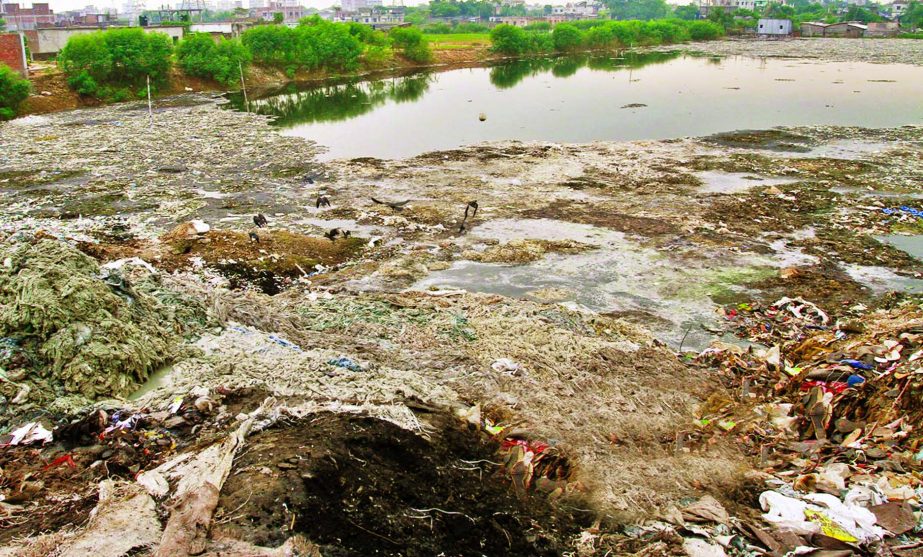
Shah Alam Nur :
The pollution level at Hazaribagh tanneries is increasing day by day because there is no preventive measure, and thereby breeds and expands disease.
The tanneries emit daily about 21,600 cubic meters of environmentally hazardous toxic waste, and around 300 different harmful chemicals.
More than 59 per cent of the total waste comes from processing of hides and skin, and accumulated in the swamp-sludge.
Experts said, the process of tanning produces both liquid and solid waste. Solid wastes are from the initial and final stages of processing while the effluents are produced mostly during tanning and dying.
Out of 214 tanneries, 200 are located near the capital’s river systems – the Turag in the northwest, the Buriganga in the southwest and the Sitalakkhya in the southeast, with Turag flowing into the Buriganga.
The tanneries produce 14910 metric tons of effluents or wastewater during the peak time, about 9100 metric tons during the off-peak period.
The effluents contain dissolved lime, hydrogen sulfide, acids, chromium dyes, oils, organic matter and suspended solids.
The waste water is discharged into open drains and ultimately finds way onto land surface and into natural water in the vicinity.
About 3000 tons of sodium sulfide and nearly 3000 tons of basic chromium sulfates are used each year for leather processing and tanning.
The other chemicals used in the tanning industry are non-ionic wetting agents, bactericides, soda ash, calcium oxide, ammonium sulfate, ammonium chloride, enzymes, sodium bisulfate, sodiumchlorite, sodium hypochlorite, sodium chloride, sulfuric acid, formic acid,
sodium formate, sodium bicarbonate, vegetable tannins, syntans, resins, polyurethane, dyes, fatemulsions, pigments, binders, waxes, lacquers and formaldehyde.
Dr MA Matin, General Secretary of Bangladesh Poribesh Andolon said “Most of the waste effluents are subjected to natural decomposition in the environment, creating serious pollution problems affecting soil, water, air and human life.”
He said, the tanneries produce 150 metric tonnes of solid wastes every day contaminating the environment and water of the metropolis.
He said that the existing industries in most cases did not have any effluent treatment plants for neutralising the toxicity and harmful effects of their pollutants.
During monsoon months, the flood protection embankments protect Dhaka from heavy flooding, while making it difficult to flush out waste water, thereby creating environmental hazard.
During the dry season the waste water is flushed out into the river polluting the river water and affecting the aquatic flora and fauna. The dumping of the solid wastes is seriously affecting the soil and plants, besides vitiating the air, groundwater and human health.
The pollution level at Hazaribagh tanneries is increasing day by day because there is no preventive measure, and thereby breeds and expands disease.
The tanneries emit daily about 21,600 cubic meters of environmentally hazardous toxic waste, and around 300 different harmful chemicals.
More than 59 per cent of the total waste comes from processing of hides and skin, and accumulated in the swamp-sludge.
Experts said, the process of tanning produces both liquid and solid waste. Solid wastes are from the initial and final stages of processing while the effluents are produced mostly during tanning and dying.
Out of 214 tanneries, 200 are located near the capital’s river systems – the Turag in the northwest, the Buriganga in the southwest and the Sitalakkhya in the southeast, with Turag flowing into the Buriganga.
The tanneries produce 14910 metric tons of effluents or wastewater during the peak time, about 9100 metric tons during the off-peak period.
The effluents contain dissolved lime, hydrogen sulfide, acids, chromium dyes, oils, organic matter and suspended solids.
The waste water is discharged into open drains and ultimately finds way onto land surface and into natural water in the vicinity.
About 3000 tons of sodium sulfide and nearly 3000 tons of basic chromium sulfates are used each year for leather processing and tanning.
The other chemicals used in the tanning industry are non-ionic wetting agents, bactericides, soda ash, calcium oxide, ammonium sulfate, ammonium chloride, enzymes, sodium bisulfate, sodiumchlorite, sodium hypochlorite, sodium chloride, sulfuric acid, formic acid,
sodium formate, sodium bicarbonate, vegetable tannins, syntans, resins, polyurethane, dyes, fatemulsions, pigments, binders, waxes, lacquers and formaldehyde.
Dr MA Matin, General Secretary of Bangladesh Poribesh Andolon said “Most of the waste effluents are subjected to natural decomposition in the environment, creating serious pollution problems affecting soil, water, air and human life.”
He said, the tanneries produce 150 metric tonnes of solid wastes every day contaminating the environment and water of the metropolis.
He said that the existing industries in most cases did not have any effluent treatment plants for neutralising the toxicity and harmful effects of their pollutants.
During monsoon months, the flood protection embankments protect Dhaka from heavy flooding, while making it difficult to flush out waste water, thereby creating environmental hazard.
During the dry season the waste water is flushed out into the river polluting the river water and affecting the aquatic flora and fauna. The dumping of the solid wastes is seriously affecting the soil and plants, besides vitiating the air, groundwater and human health.

